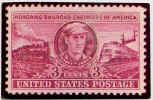 |
 |
| Here is the engine named "Casey" Jones: |
| The "Casey Jones" IC Locomotive Nr. 382 is featured in the "Leaders of the World" series on the 10c Sc. #236 (6/29/84) se-tenant pair of TUVALU (excellent illustrations). ~~~~~~~~~~~~~~~~~~~~~~~~~~~~~~~~~~~~~~~~~~~~~~~~~~~~~~~~~~~~~~~~~~~~~~~~~~~~~~~~~~~ |
 |
| One of the ironies of the Casey Jones legend is that the locomotive the famed engineer rode to his death was
never, as a class, known for its speed. Unlike the 4-4-0, which rolled through its 50 years of supremacy on drivers of six feet and
more, and the 4-6-2 which handled fast trains during the next four decades, the 4-6-0 or
"ten-wheeler" Casey drove seldom had drivers larger than 69
inches. It lasted less than 20 years in high-speed service. Ten-wheeler No. 382 was one of 40 built by Rogers between 1896 and 1900 and four built by Pittsburgh in 1901, all for mainline passenger service on the Illinois Central. Their drivers were 69 inches, big for a 4-6-0, and the IC liked the design. It suited the smooth right-of-way on the Chicago-to-New Orleans route, with its few sharp curves and gentle hills. During the 1890s and for many years thereafter, a train which averaged 40 mph was considered fast. It required constant running at 55 to 60, and faster when making up time. No. 382 was equal to the work, with its Belpaire firebox and Stephenson gear (later changed to Baker gear and piston valves), and so was Casey Jones. He was a man who hated to run late. In the early morning hours of April 30, 1900, Jones and No. 382 were heading the "New Orleans Special," also known as the "Cannonball," a heavy night train scheduled for 40 mph. In order to make up for a late start out of Memphis, Jones had averaged 60 mph on the 100-mile run south to Grenada, with one stop. (Fifty years later, the crack streamliner "City of New Orleans" was scheduled to make the same run, still with one stop, in the same time). Jones was planning on making it into Canton, another 88 miles down the line, right on time -- and he probablly would have, if it hadn't been for a freight train which didn't quite get its tail end off the main track. Casey Jones didn't survive that encounter, but No. 382 did. Along with her sisters she was renumbered three times, and was relegated to local and branch service after 1907. She went to the scrapyard as No. 5012 in 1935, just five years before the last of this group of locomotives was removed from service. |
| TECHNICAL INFORMATION Builder - Rogers Built - 1898 Total weight - 253,300 lbs. Weight engine - 158,300 lbs. Axle load - 44,366 lbs. Total length - 59ft. 9in. Drivers - 69 inches Cylinders - 19-1//2 x 26 inches Steam pressure - 180 lbs. psi Heating surface - 2378 sq. ft. Grate area - 30 sq. ft. Fuel - Soft coal, 9 ton Water - 5000 gallons |